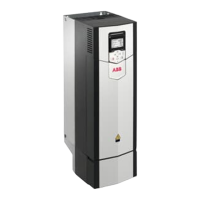Modulo operation
Modulo operation is used when a position range is repeated cyclically and could
be run continuously in one direction. The position range is typically the full
mechanical sequence of the load, such as one turn of the load shaft, or a full rotation
of a belt. A typical application is a rotary table, a turn of which corresponds to a
repeated position range of 0 to 360 degrees.
Parameters 86.18 and 86.19 define the repeated range. The product of load gear,
feed constant and modulo range defines the operating range in units. If 86.18 is
set to zero, modulo operation is disabled and 86.2 uses its default range.
Target positions within a modulo operation range will move the load by less than
one full sequence (eg. turn). If the difference between the target position and the
actual position is greater than the modulo operating range, the load will move by
more than one sequence to reach the target.
The direction of movement is defined by bits 10 and 11 of parameter 74.4. The
sources of these bits are defined by 74.30 and 74.31.
The software limits for actual position (86.60 and 86.61) are not active in modulo
operation.
■
Example
If the feed constant is set to 360, load gear to 1 and modulo range to 1, the actual
position range is limited to 0…360 (360 × 1 × 1), excluding 360. The target position
can be set to a higher value, but actual position will roll over to zero at 360.
The graph below shows the values of 86.2 and 86.4 in a situation where the starting
position is 180 and the target position is 540, requiring a movement of 1.5 turns.
At target position, the value of 86.2 is 360 (180 + 360 = 540), and 86.4 has increased
linearly by increments within the 1.5 turns.
86.2 Actual position
86.4 Encoder 1 position
Settings and diagnostics
44 Position control program features

